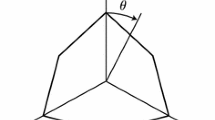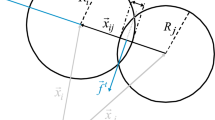Abstract
The discrete element method (DEM) is a numerical technique to simulate the mechanical behavior of a system of particles. Each particle is identified with a representative shape and size that interacts with other particles according to a contact model. Two important steps in modeling with DEM are defining model resolution (ratio of sample smallest dimension to average particle size) and sample generation. Some values of model resolution are proposed in the literature for simulations of different laboratory tests. In this study, values for model resolution are obtained for the uniaxial compressive test (UCT) simulations. Ten realizations for each scenario of model resolution were created to investigate its influence on the properties obtained by the UCT simulations. The values we suggest for model resolution are the ones with a good tradeoff between computational effort and property variations obtained by the DEM simulations. There are several methods for sample generation, considering a static or a dynamic approach. After comparing different techniques, a sample generation method is proposed, where a static algorithm is combined with a dynamic procedure. This generation technique is recommended to achieve dense packing while showing a low influence of particle assembly on the mechanical properties obtained by the DEM simulations.













Similar content being viewed by others
Abbreviations
- \(A\) :
-
Contact surface from the contact model
- \(E\) :
-
Macro-Young`s modulus
- \(\mathrm{EF}\) :
-
Enlarge factor parameter from the contact model
- \(F\) :
-
Force among particles
- \({F}_{\mathrm{n}}^{max}\) :
-
Maximum cohesive tensile force from the contact model
- \({F}_{\mathrm{s}}^{max}\) :
-
Maximum cohesive shear force from the contact model
- \({N}_{\mathrm{c}}\) :
-
Total number of contacts among particles
- \({N}_{\mathrm{p}}\) :
-
Number of particles
- \(R\) :
-
Radius from particles
- \({V}_{\mathrm{s}}\) :
-
Sum of all particle volumes (solid volume)
- \({V}_{\mathrm{t}}\) :
-
Sample total volume
- \(Y\) :
-
Micro-Young`s modulus from the contact model
- \(Z\) :
-
Coordination number
- \(c\) :
-
Cohesion from the contact model
- \(e\) :
-
Sample porosity
- \(f\) :
-
Front from the sphere generation algorithm
- \(k\) :
-
Stiffness from the contact model
- \(r\) :
-
Sphere radius from the sphere generation algorithm
- \(t\) :
-
Tensile strength from the contact model
- \(u\) :
-
Overlap between particles
- \(\text{vr}\) :
-
Sample void ratio
- \(\mathrm{dist}\) :
-
Distance between particle centers
- \(\text{micro}\_\nu \) :
-
Micro-parameter Poisson`s coefficient
- \({\delta }_{\mathrm{box}}\) :
-
Box size from the sphere generation algorithm
- \(\Delta \) :
-
Increment
- \(\phi \) :
-
Friction angle from the contact model
- \(\nu \) :
-
Macro-Poisson’s coefficient
- \(\sigma \) :
-
Stress
- \(\epsilon \) :
-
Strain
- \({\left[\right]}_{\mathrm{n}}\) :
-
Normal
- \({\left[\right]}_{\mathrm{s}}\) :
-
Shear
References
Cundall PA, Strack ODL (1979) A discrete numerical model for granular assemblies. Géotechnique 29(1):47–65
Behraftar S, Torres SAG, Scheuermann A, Williams DJ, Marques EAG, Avarzaman HJ (2017) A calibration methodology to obtain material parameters for the representation of fracture mechanics based on discrete element simulations. Comput Geotech 81:274–283
Jiang M, Chen H, Crosta GB (2015) Numerical modeling of rock mechanical behavior and fracture propagation by a new bond contact model. Int J Rock Mech Min Sci 78:175–189
Jiang MJ, Konrad JM, Leroueil S (2003) An efficient technique for generating homogeneous specimens for DEM studies. Comput Geotech 30(7):579–597
Nguyen NHT, Bui HH, Nguyen GD, Kodikara J (2017) A cohesive damage-plasticity model for DEM and its application for numerical investigation of soft rock fracture properties. Int J Plast 98:175–196
Schöpfer MPJ, Childs C, Walsh JJ (2007) Two-dimensional distinct element modeling of the structure and growth of normal faults in multilayer sequences: 1. Model calibration, boundary conditions, and selected results. J Geophys Res Solid Earth 112(10):1–15
Potyondy DO, Cundall PA (2004) A bonded-particle model for rock. Int J Rock Mech Min Sci 41(8):1329–1364
Scholtès L, Donzé FV (2012) Modelling progressive failure in fractured rock masses using a 3D discrete element method. Int J Rock Mech Min Sci 52:18–30
Berger KJ, Hrenya CM (2014) Challenges of DEM : II. Wide particle size distributions. Powder Technol 264:627–633
Ding X, Zhang L, Zhu H, Zhang Q (2014) Effect of model scale and particle size distribution on PFC3D simulation results. Rock Mech Rock Eng 47(6):2139–2156
Xu X, Wu S, Gao Y, Xu M (2016) Effects of micro-structure and micro-parameters on Brazilian tensile strength using flat-Joint model. Rock Mech Rock Eng 49(9):3575–3595
Brugada J, Cheng YP, Soga K, Santamarina JC (2010) Discrete element modelling of geomechanical behaviour of methane hydrate soils with pore-filling hydrate distribution. Granul Matter 12(5):517–525
Liu H, Zou D, Liu J (2008) Particle shape effect on macro-and micro behaviours of monodisperse ellipsoids. Int J Numer Anal Methods Geomech. 32:189–213
Han K, Feng YT, Owen DRJ (2005) Sphere packing with a geometric based compression algorithm. Powder Technol 155(1):33–41
Lopes LGO, Cintra DT, Lira WWM (2020) A geometric separation method for non-uniform disk packing with prescribed filling ratio and size distribution. Comput Part Mech 8:169–182
Frery AC, Rivarola-Duarte L, Ramos VCL, Ramos AS, Lira WWM (2012) Stochastic particle packing with specified granulometry and porosity. Granul Matter 14(1):27–36
Feng YT, Han K, Owen DRJ (2003) Filling domains with disks: an advancing front approach. Int J Numer Methods Eng 56(5):699–713
Lozano E, Roehl D, Celes W, Gattass M (2016) An efficient algorithm to generate random sphere packs in arbitrary domains. Comput Math with Appl 71(8):1586–1601
Lozano E (2016) “https://git.tecgraf.puc-rio.br/elozano/packgen,”
Scholtès L, Donzé F-V (2013) A DEM model for soft and hard rocks: role of grain interlocking on strength. J Mech Phys Solids 61:352–369
Yoon J (2007) Application of experimental design and optimization to PFC model calibration in uniaxial compression simulation. Int J Rock Mech Min Sci 44(6):871–889
De Simone M, Souza LMS, Roehl D (2019) Estimating DEM microparameters for uniaxial compression simulation with genetic programming. Int J Rock Mech Min Sci 118:33–41
Šmilauer V et al. (2015) “Reference manual.” Yade Documentation 2nd ed
Pinto A (2009) Algoritmo para geração de arranjos de partículas para utilização no método dos elementos discretos
Xiao Y, Tutumluer E (2016) Gradation and packing characteristics affecting stability of granular materials: aggregate imaging-based discrete element modeling approach. Int J Geomech 17(3):04016064
Chen X, Miedema SA, Van Rhee C (2017) Application of parallel bond method in rock cutting simulation. In: The 5th international dredging technology development conference of China, pp 2628
Cho N, Martin CD, Sego DC (2007) A clumped particle model for rock. Int J Rock Mech Min Sci 44(7):997–1010
Acknowledgements
The authors gratefully acknowledge support from the Brazilian National Council for Scientific and Technological Development CNPq (Grant 308547/2016-0) and FAPERJ (Grant CNE 202.928/2019).
Author information
Authors and Affiliations
Corresponding author
Ethics declarations
Conflict of interest
The authors have no competing interests to declare that are relevant to the content of this article.
Additional information
Publisher's Note
Springer Nature remains neutral with regard to jurisdictional claims in published maps and institutional affiliations.
Rights and permissions
Springer Nature or its licensor (e.g. a society or other partner) holds exclusive rights to this article under a publishing agreement with the author(s) or other rightsholder(s); author self-archiving of the accepted manuscript version of this article is solely governed by the terms of such publishing agreement and applicable law.
About this article
Cite this article
De Simone, M., Lozano, E. & Roehl, D. The influence of sample generation and model resolution on mechanical properties obtained from DEM simulations. Comp. Part. Mech. 10, 1827–1841 (2023). https://doi.org/10.1007/s40571-023-00592-z
Received:
Revised:
Accepted:
Published:
Issue Date:
DOI: https://doi.org/10.1007/s40571-023-00592-z




